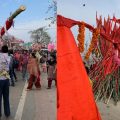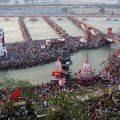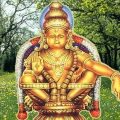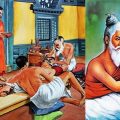Ayurveda Since 29102 BCE; Bharadvaja Revived Tradition, Here is How
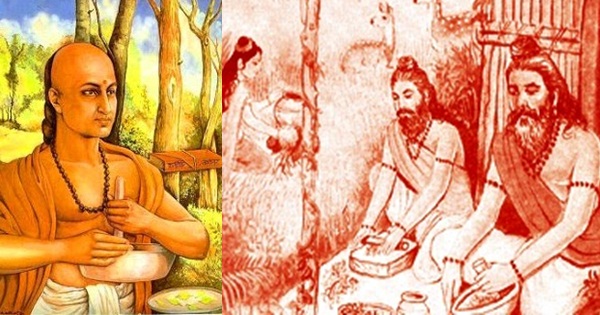
Western authors lack sense of history or knowledge of any calendar system and are following 23-10-4004 BC as start of creation interpreted from Bible. Āyurveda started in Siddha era before Svāyambhuva Manu (29102 BC). After that, it was revived and improved by Uśnā (Śukra), Indra, Dakśa Prajāpati, Aśvinī-kumāra (Dasra and Nāsatya). After Vaivasvata Manu (13902 BC) it was revived after glacial floods in about 10000 BC by Bhradvāja, who revived the tradition of Indra and taught to Ātreya-Punarvasu who taught Charaka-samhitā to Agniveśa, Bhela, Jātūkarŋya, Parāśara, Harita, and Kśārapāŋi. Around Mahābhārata time, it was written by Charaka, who might be Vaiśampāyana, who classified branches of Vedas. Charaka is one of branches of Kŗşŋa-Yajurveda. It was improved by Dŗɖhabala.
The Āyurveda text or its commentary was written by Patañjali who also wrote Yoga-sūtras, commented by Veda-Vyāsa. He explained grammar-sūtras of Pāŋini with Vārtika of Kātyāyana. It was lost and revived last time by Govinda-pāda, guru of Ādi-Śankara in about 600 BC. Tradition of surgery was started by Dhanvantari at time of Kūrma incarnation in 15800 BC when Devas and Asuras joined hand for mineral exploration called Samudra-manthana. King Divodāsa, of Kāśī is called incarnation of Dhanvantari as he revived it. Suśruta in his tradition wrote Suśruta-samhitā. Kaśyapa-samhitā was in about 17500 BC which specialized in infant diseases and poisons. It was revived by Vŗddha-Jīvaka and Rāvaņa. Last of old texts is Aşţānga-Hŗdaya by Vāgbhaţa, who was in about 700 BC after Vişņu incarnation Buddha born to Brāhmaņa Ajina of Magadha.
Āyurveda is science of giving life. Human body suffers defects or diseases due to genetic, environment, daiva (acts in past life, surroundings), food, mind, injury. 5 types of hospitals were maintained for free treatment-medicine, surgery, psychiatry, poison/infections, and injuries. There was a separate veterinary hospital. Old texts went to Greek via Arab and Hippocrates started western system. Arabic system is still called Unani medicine. Homeopathic system is mentioned in Charaka-samhitā and still exists in Taittirīya–samhitā.
Destruction of History by Western Authors
Herodotus (484-425 BC) of Greece is considered father of history (western) followed by Thucydides (454-399 BC). Their main aim was to show that civilization did not exist anywhere else and it started in Greece only. Frequent attack by Persians forced their mention, but all references to any knowledge from Egypt is omitted. That destruction of history was completed by Alexander (352-325 BC) who destroyed vast libraries of Alexandria and Persipolis in Persia. Euclid had gone to Alexandria to learn axiomatic geometry. Appolonius of Perga also had gone there to learn conic-sections, but had to visit India to learn and write book of that name. But Till today, western historians like David Pingree, completely ignorant of mathematics quote their own articles to show that mathematics has come from Sumeria to India. It is tendency of religions in west Asia to destroy everything prior to their prophet, and the trend continued all over Europe where all pre-christian remains were destroyed. Even afterwards, all non-christian knowledge was destroyed and followers were burnt alive. After start of British rule in India, the trend intensified to destroy all old books and misinterpret the remaining.
In Kerala itself, over 16000 palm leaf manuscripts of were destroyed by British government to remove competition to western allopathic medicine. Oriental Institutes were set up in Calcutta and Puna to replace Indian chronology and history by destroying and changing records. To streamline destruction of history, Boden chair was set up in Oxford in 1831 with declared aim of destroying Vedic history and culture, so that Christianity can be spread in India. Indian followers like Radhakrishnan, P.V. Kane, R.D. Bhandarkar and R.C. Mazumdar were more loyal than the king. After Radhakrishnan became President, 3 ordnances were brought to remove traditional Sanskrit scholars like Ramvyasa Pandey of BHU and B. R Sharma of Tirupati who had actually seen Sanskrit texts. Kauthumī samhitā of Sāmaveda was sent from Tirupati to Harvard for publication.
Chief Justice M. Hidayatullah passed severe stricture on ordnances issued telling that all traditional Sanskrit scholars are to be removed as soon as they ‘fall sick or die for good’ (1961 AIR 1059 1961 SCR (3) 380). R.C. Mazumdar in his original book-Ancient India, page 135 had given strength of army of Andhra kings on authority of Megasthenes quoted by Pliny etc. But that indicated Gupta period at time of Alexander, so he omitted that from next book in collaboration of K.K. Dutta and H.C. Raichaudhary to show that Alexander attacked at start of Maurya empire. For that loyalty, he was made General Editor of 12 volume history of Bhartiya Vidya Bhawan. Usmania university maintains both contradictory versions-reference to Andhra kings for culture department and Maurya period for history.
About 90% students of history honours take Hindi or other regional language as side subject, where they read that local languages started by Gorakhanātha in eighth century, but in history they take it as period of Śankarāchārya. All devotees of Marx/Oxford start fighting when anybody talks about calender, or geography. Megasthenes has described Delhi (Palibothri =Prabhadraka) with pillar of Hercules (Kutub-minar) on banks of Yamuna, but that is to be shown Patna, about 1200 kms away, so geography and chronology are to be avoided.
Indian Chronology
In Vedic system, there are 7 yugas, out of which 2 large eras are used for astronomy and geological periods. Remaining 5 are used for historical eras. Astronomical era is of 12000 divya years. In astronomy, divya year means 360 solar years, but in history, it means solar year. Vāyu purāņa tells saptarşi era of 3030 Mānuşa years (of 12 rotations of moon in 327 days) or of 2700 divya years (equal to solar year of 365.25 days). Manvantara in astronomy is axial rotation period of galaxy of 71 astro yugas= 306.8 million years. But Historical manvantara is defined in Brahmāņɖa purāna (1/7/26) of 26000 years which is equal to rotation period of earth axis around perpendicular to ecliptic (called precession). That period had passed from Svāyambhuva Manu to 3102 BC when Kali started.
Till Vaivasvata Manu, 16000 years had passed equal to 43 yugas of 360 years and then 28 yugas till kali start. Ayanābda yuga of 24000 years has been used in Vāyu purāņa with two parts of Avasarpiņī and Utsarpiņī of 12000 years each. First part is Avasarpiņī starting with Saya, Tretā, Dvāpara, kali of 4800, 3600, 2400, 1200 years. Second part is Utsarpiņī with yugas in reverse order. This system started with Vaivasvata Manu, so Brahmā or Svāyambhuva Manu has been stated in initial tretā, he did not start system from Satya yuga. 24000 year cycle matches cycle of geological flood/ice more correctly than modern estimate of 21600 years cycle. It combines rotation of earth’s apogee in 100000 years and precession in 26000 years in reverse direction. In India, long term component of 312000 years of apogee rotation has been merged-
1/26000 + 1/312000 =1/24000.
Each yuga has been divided into parts of 360 years. Detailed chart is in my book-‘Sānkhya-siddhānta’, or in ‘Vedic View of Śrī Jagannātha’. Glacial floods were in 31000 and 10000 BC as per modern estimates and Indian chart which were breaks in progress of civilization. In middle periods of glacial ice, center of civilization shifted near equator. In periods of flood, it moved to north temperate zone. India survived major changes due to shielding by Himalayas, so all Greek historians have written that India had always been self sufficient in food and never attacked any country is past 15000 years. Last attack was by Kārttikeya who had destroyed Krauñcha Dvīpa (north America) in 15800 BC. Language of his navy called Mayūra still survives as Maori all over Pacific ocean. Ayanābda yuga is called day of human Brahmā, and now third day is running from Vaivasvata Manu in 13902 BC.
Ayurveda
It started 3 yugas earlier prior to Svāyambhuva Manu-
या ओ॑षधीः॒ पूर्वा जा॒ता देवेभ्यस्त्रियुगं पुरा । (ऋक् १०/९७/३, वा. यजु १२/७५, तैत्तिरीय संहिता ४/२/६/१, निरुक्त ९/२८)
=These medicines were created by Devas 3 yugas back.
Period prior to Devas has been called Sādhya yuga in Puruşa sūkta (Yajurveda 31/16)-
य॒ज्ञेन॑ य॒ज्ञम॑यजन्त दे॒वास्तानि॒ धर्मा॑णि प्रथ॒मान्या॑सन् ।
ते ह॒ नाकं॑ महि॒मानः॑ सचन्त॒ यत्र॒ पूर्वे॑ सा॒ध्याः सन्ति॑देवाः॥१६॥ (वा. यजुर्वेद ३१/१६)
=Devas worshipped (linked) yajña through yajña only. Those were the first dharmas. Those great men reached the top (nāka=pole of the sphere of solar system). In nāka of earth (north of India), the Sādhyas lived who were Devas of earlier period.
The scholars of were called siddhas whose system of medicine was called siddha system and is still used in south India with that name. The siddhas are also worshipped daily in 5 Namokāra mantras of jainas. When all yajña systems were united by Brahmā under umbrella of Vedic unification-it was part of the original Atharva Veda. When it was classified into 4 vedas and 6 angas, it became a separate Upa-veda called Āyurveda. As internal yajña of management of body, it is part of Yajurveda. Physicians were moving and were called Charaka, which means a moving sanyāsī in general. In China also, they were called foot-doctors. Charaka-samhitā is a separate branch or rendering of Kŗşņa Yajurveda. Most of medicinal herbs are described in Atharva veda and some medicines are in Ŗgveda also. There are detailed references of treatments in each of the 40 chapters of Vājasaneyī yajuveda, compiled by author is a separate article. The first verse itself tells that we should be free from Amīvā (Amoeba) i.e. infections, and from Yakśmā (tuberculosis)-
ॐ इ॒षे त्वो॑र्जे त्वा॑ वा॒यव॑ स्थ दे॒वो वः॑ सवि॒ता प्रार्प॑यतु आप्या॑यध्व मघ्न्या॒ इन्द्रा॑य भा॒गं प्र॒जाव॑तीरनमी॒वा अ॑य॒क्ष्मा मा व॑ स्तेन ई॑षत माघशँ॑सो ध्रुवा अ॒स्मिन् गोप॑तौ स्यात ब॒ह्वीर्यजमा॑नस्य प॒शून्पा॑हि (वा. यजु १/१)
In fact, if we take the internal meaning of opening verse of Yajurveda, it indicates all the subjects of Charaka-samhitā. Flow of energy from Sun has been called Īşā, it is central axis of all life, so it is called Īşā-daŋɖa (axle rod) of ratha of sun. Its measure is given in Bhāgavata purāŋa, part 5 as 6000 yojana (1 yojana = sun diameter). In human body, it is spinal cord which links brain with body. Sun in space is life, its image digestive system around maŋipūra-chakra feds the body. Here, cow is called Aghnyā, i.e. not to be killed. In general, ‘go’ means sun-rays, any place (e.g. earth) where yajña is done, yajña itself, and human organs. Thus all as cycle of production are to be maintained and only its remains are to be consumed as taught in Gītā (3/10-16). If we maintain chain of yajña starting with human body and organs, family and Indra (king , space radiation) we will be bestowed with Prajā, will remain free of any infection and decay. We will not take due of others. ‘Gha’-the fourth letter indicates 4 Puruşārtha (aims of human life). Not following the path is agha =sin. We should not deviate from Puruşārtha which is taught by Charaka by maintaining healthy life. Then man and society will run steadily and wealth will increase.
On earth surface, agriculture is base for all other yajña. So the rod of plough (Hala) is called Īşā or Harīşa (hal+īşa). That is put to start any worship whip is a model of all yajña. It is also called yūpa-dāru (wood for central axle). If that axle is kept moving for efficient agriculture (agri =first of culture), we remain healthy, wealthy and do not need other’s wealth.
Vāyu purāŋa gives sequence of pioneers (Āchāryas) staring with Dhanvantari at time of Samudra-manthana (explration of minerals) in 15800 BC. In second Dvāpara, Dhanvantari-2 (like original, his incarnation) was born as Divodāsa, son of Śaunahotra, king of Kāśī. Āyurveda with science of medicine was written by Bharadvāja who divided into 8 parts and taught to disciples.
द्वितीये द्वापरे प्राप्ते सौनहोत्रः प्रकाशिराट् । पुत्रकामस्तपस्तेपे नृपो दीर्घतपास्तथा ॥१८॥
तस्य गेहे समुत्पन्नौ देवो धन्वन्तरिस्तदा । काशिराजो महाराजः सर्वरोगप्रणाशकः ॥१९॥
आयुर्वेदं भरद्वाजश्चकार सभिषक् क्रियम्। तमष्टधा पुनर्व्यस्य शिष्येभ्यः प्रत्यपादयत ॥२०॥
(वायु पुराण, अध्याय, ९२)
Śaunahotra in second Dvāpara—Dhanvantari-2 = king of Kāśī—Ketumān—Divodāsa = Bhīmaratha —Pratardana. This Divodāsa is famous in Vedas in time of Dāśarāja war in about 7000 BC from Persian sources and second dvāpara indicated here. Same is found in Harivamśa (1/29/22-27) and Brahmāŋɖa purāŋa, upoddhāta (3/67/24).
Charaka-samhitā itself gives start of this science. Indra had preserved the medicine systems developed by Sādhyas. Deva supremacy was for 10 yugas or 3600 years from 17500 to 13902 BC in which there were 14 main Indras who ruled for about 100 years each called Śatakratu (100 yajña for 100 years). Group of Ŗşis deputed Bharadvāja to bring the knowledge of Āyurveda from Indra. He went there and brought the mass of knowledge.
स वक्ष्यति अमोपायं यथावद् इन्द्रप्रभुः । कः सहस्राक्ष भवनं गच्छेत् प्रष्टुं शचीपतिम् ॥१८॥
अहमर्थे नियुज्येयं अत्रेति प्रथमं वचः। भरद्वाजोऽब्रवीत् तस्माद् ऋषिभिः स नियोजितः ॥१९॥
स शक्र भवनं गत्वा सुरर्षिगण मध्यगम् । ददर्श बलहन्तारं दीप्यमानमिवानलम् ॥२०॥
(चरक संहिता, सूत्रस्थान, अध्याय, १).
In Taittirīya Brāhmaŋa (3/10/11), it is stated that Bharadvāja spent 3 lives with Brahmacharya to study Vedas by grace of Indra. At end he became very old and bed-ridden. Then Indra asked what he would do if offered a fourth life of 100 years. He stated that he will complete his study of Vedas. Indra showed him 3 mountains as form of 3 vedas and took fistful of dust from each-telling that Bharadvāja had got knowledge equal to that.
भरद्वाजो ह वै त्रिभिरायुर्भिर्ब्रह्मचर्य्यमुवास । तं ह जीर्णि स्थविरं शयानं इन्द्र उपब्रज्य उवाच । भरद्वाज ! यत्ते चतुर्थमायुर्दद्यां, किमेनेन कुर्य्या इति ? ब्रह्मचर्य्यमेवैनेन चरेयमिति होवाच । तं ह त्रीन् गिरिरूपानविज्ञातानिव दर्शयाञ्चकार । तेषां हैकैकस्मान्मुष्टिमाददे । स होवाच, भरद्वाजेत्यमन्त्र्य । वेदा वा एते । “अनन्ता वै वेदाः” । एतद्वा एतैस्त्रिभिरायुर्भिरन्ववोचथाः । अथ त इतरदनूक्तमेव । (तैत्तिरीय ब्राह्मण ३/१०/११)
After return from Indra, Bharadvāja presided over a conference of Ŗşis at Himalaya. Many Ŗşis have been listed here who are of different eras. That indicates the process of Samhitā-it is a collection of wisdom of at different times. It is Apauruşeya (beyond human) in that sense as it is not creation of a single man. Actually, all science texts include discoveries of different scientists of different periods. It also indicates that names of Ŗşis are related to the subject of knowledge-Kāpya tells about Kapha, Vāyorvid tells about Vāyu-doşa. Pitta is due to sun in 6th house of horoscope, or over action of sun at navel center, so its teacher is called Marīchi = sun. Even the main organizer is called Ātreya Punarvasu. Atri is primordial Ŗşi which is single and it does Pūşaņa = nourishment-
पूषन्नकर्षे यम-सूर्य प्राजापत्य व्यूह रश्मीन् समूह । तेजो यत्ते रूपं कल्याणतमं तत्ते पश्यामि योऽसावसौ पुरुषः सोऽहमस्मि ॥ (ईशावास्योपनिषद् १६)
=Pūşā is the single ŗşi which is creative (Prājāpatya) by linking Yama (to regulate, sink as opposite of sun) and which collection of radiations from Sūrya (sun). Your form is brightness, its most beneficial part we see. I am the same Puruşa, which You (Supreme) are.
Finally, filling by text is by Bharadvāja (bhara = to fill).
Opening chapter of Charaka-samhitā gives sequence of development of Āyurveda-(1) Brahmā among Sādhyas was the first to compile Āyurveda , (2) He gave it to Prajāpati (Dakśa and others got it from 7 Brahmās later on), (3) Dakśa gave it to Aśvinī-Kumāras (twins called Dasra and Nāsatya), (4) From Aśvinī-Kumāras, Indra got it, (5) From Indra, Bharadvāja got it, (6) Bharadvāja taught it to many Ŗşis, in particular Punarvasu Ātreya. (7) Punarvasu Ātreya taught it to 6 disciples-among whom Agniveśa was the first to compile a tantra. Remaining 5 students also wrote tantras in their name-Bhela, Jatūkarŋa, Parāśara, Hārīta, Kśārapāŋi. (8) It was revised by Dŗɖabala, (9) At beginning of Kali it was written or commented by Patañjali. Vijñāana-Bhikśu in his Yoga-Vārtika has prayed as creator of Yoga-sūtra, commentary on grammar, and Āyurveda. Charaka has been called Vaiśampāyana also, which is a gotra name. After Vyāsa, he might have spread it. Vaiśampāyana might have compiled existing material and Patañjali wrote commentary as he did for grammar.
योगेन चित्तस्य पदेन वाचा मलं शरीरस्य तु वैद्यकेन ।
योऽपाकरोत्तं प्रवरं मुनीनां पतञ्जलिं प्राञ्जलिरानतोऽस्मि ॥
Patañjali was contemporary ofVedavyāsa (c3200-3090 BC) and Pāŋini. Pāŋini wrote 4000 sūtras of grammar. Kātyāyana wrote Vārtika to supplement or explain them. On sūtras and Vārtika both, Patañjali wrote his commentary Mahābhāşya. Vedavyāsa wrote commentary on Yoga-sūtra of Patañjali.
This contemporary nature has these effects-(1) Charaka samhitā indicates beginning of Veda creation. Its last part shows last version at time of Kŗşņa-Dvaipāyana-Vyāsa. Last summary is in Gītā, whose technical explanation is only in this book-about effect of past and present deeds and surroundings. (2) As yoga-sūtras were written by same Patañjali, it is also explanation of that. (3) It is an explanation of 2 streams (nişţhā) of past Sānkhya and Yoga indicated in Gītā–
लोकेऽस्मिन्द्विविधा निष्ठा पुरा प्रोक्ता मयानघ ।
ज्ञानयोगेन सांख्यानां कर्मयोगेन योगिनम् ॥ (३/३)
Grammar of Patañjali was lost twice, it was revived first in Kashmir in time of 52nd Gonanda king Abhimanyu (1234-1182 BC) (-Rājatarangiŋī of Kalhaŋa) and then in Ujjain by Govindapāda, guru of Śankarāchārya (509-476 BC) i.e. in about 600 BC (Kathā-sarit-sāgara, Bhaviśya purāŋa). Thus, it contains reference of Puşyamitra Śunga (1218-1158 BC).
The last edition of Charaka and Suşruta samhitās was in time of Vikramāditya of Ujjain (82BC-19 AD), who started his Samvat, standard ill today for all festivals. One of the 9 jewels of his court has been called Dhanvantari who did the last edition.
Other Traditions
Patañjali has been called incarnation of Śeşa or Ananta. Tradition of surgery is by Dhanvantari, incarnation of Vişŋu, sleeping on Ananta. Thus, scope of Charaka is more general. Surgery is a part of it. Dhanvantari was born at time of war between Devas and Asura for sharing products of Samudra-manthana. To cure injuries from war, surgery is more needed.
Among Asuras also, Uśnā or Śukrāchārya developed Mŗta-sañjīvanī ( reviving dead) for war injuries only. That tradition continued till Suşeŋa, physician of Rāvaŋa, who had revived Lakśmaŋa. Till today, this system partly survives at Kalupada in Orissa and Poteru near Tirupati. In Vedānta also, Rāmānuja is incarnation of Ananata, as he combines Abstract unitary source with visible forms. Śankarāchārya describes abstract only. Suśruta-samhitā specializes in surgery. Like Charaka, Suśruta also means well read (śruti= veda). Dhanvantari literally means surgeon-
धनुः शल्यं पारं अन्तं इयर्ति गच्छति इति धन्वन्तरिः
= Dhanvantari is a person who inserts instrument for treatment.
Suśruta-samhitā itself tells its tradition (Sūtra-sthāna, 1/20)-(1) Brahmā, (2) Prajāpati, (3) Aśvinī–kumāra, (4) Indra, (5) Dhanvantari.
In second incarnation (1/3)-(6) Bharadvāja, (7) Dhanvantari-2 or Divodāsa, king of Kāśī, (8) Aupadhenava, Viataraŋa, Aurabhra, Pauşkalāvata, Karavīrya, Gopura-rakśita, Suşruta etc, (and Kalāyāna, Gārgya). Later Suşruta-2 may be around Mahābhārata time-slightly after Charaka, who does not mention it.
Kaśyapa-samhitā is very old and specialized in pediatrics (kaumāra-bhŗtya) and poisons. It passed on to Vŗddha-Jīvaka, then to Rāvaŋa. Later on, Vyāsa got it from a Yakśa-Anayasa. Vāgabhaţa wrote Aşţānga-hŗdaya and has prayed Buddha, but is devotee of Hara and Hari also. He should be just after Vişŋu incarnation Buddha, son of Brāhmaŋa Ajina of Magadha who had united 4 leading kings of Agni-kula in a yajña at mount Abu in 756 BC under king Śūdraka–Paramāra, Pratihāra, Chālukya, Chāhamāna– to check attacks of Asuras in Assyria.
Finally, king Chāhamāna completely destroyed Nineve, capital of Assyria in 612 BC mentioned repeatedly in old testament of Bible. Durgā-saptaśatī, chapter 11 indicates Śākambharī incarnation at that time, so the kings were called Chauhānas of Śākambharī. Then a Śaka was started indicated by Varāhamihira in Bŗhat-samhitā (13/3). Works of Charaka-Suśruta-Vāgabhaţa are called Bŗddha–trayī or great 3. Vāgabhaţa mentions interesting historical reference that the liquor of barley was started by Dionysus who had captured north-west India in 6777 BC. He has been called Bacchus in Bible, so the drink is called whisky.
Special Features
Charaka-samhitā, classifies the whole medical science in 8 parts-(1) Kāya–chikitsā-body treatment by medicine, (2) Children’s diseases (Bāla-roga), (3) Para-psychology (Graha or Bhūta-bādhā), (4) ENT (Śālākya, limbs above neck), (5) Surgery (Śalya), (6) Poison (Vişa), (7) Old age (Jarā, or rasāyana), (8) Gaining strength (Vājī-karaŋa).
In modern medicine also, man is affected by climate, but goes far beyond that. Man is a complete image of cosmos. It is written in Genesis (1/27) also-God created man after his own image. In Charaka-samhitā, śarīra-sthāna (5/2), it is written-
पुरुषोऽयं लोकसम्मित इत्युवाच भगवान्पुनर्वसुरात्रेयः, यावन्तो हि लोके मूर्त्तिमन्तो भावविशेषास्तावन्तः पुरुषे, यावन्तः पुरुषे तावन्तो लोके ।
Due to multi link of man with world, his well being is affected by planets of solar system, mantras, herbs of many kinds.
In particular it is only theory which can explain homeopathy which has 5 un-explained processes by modern science-(1) Medicine is prepared only in alcohol solution, not in water, oil or milk, (2) By dilution, power of medicine increases, (3) Dilution is always in steps of 100, (4) Only dilutions of 30, 200 and 1000 steps are effective, (5) Medicine of power 30 means alcohol solution diluted to 1 part in 1060. But that is number of electron-positron pair in solar system, and even in that space, no molecule can remain with that dilution. But still, medicines are effective.
Explanation in Vedas-(1) Solar system as a drop (drapsah) is floating in ocean of ethyl alcohol in vacant space of galaxy-Ŗgveda (1/154/5). (4) Medicine is an image of that process and it is effective much below atomic level. (3) Solar system has image in Maņipūra chakra in navel region. That controls digestion which is linked to most diseases. So dilution equal to electron numbers in solar system will cure most diseases. From sun as center, earth is at 200 radius and Jupiter (largest planet) at 1000 radius. So, 200 and 1000 power medicines are used. Sun controls intellect which is linked to man at speed of light. That link goes to sun and returns 3 times in 1 muhūrtta (48 minutes-Ŗgveda 3/53/8). (5) Original matter of universe was Rasa which gives Ānanda (happiness, cure). In constructing visible world, this is spent. So its amount increases 100 times as we move to rarer dhāmas (zones, loka) from earth, which is densest-Taittirīya upanişad (2/7/2 and 2/8).

Primordial mind of space was in vacuum (śvo-vasīyasa)-corresponding to sahasrāra chakra with 1000 alternatives of creation. When it desired creation, there was duality of matter, corresponding to Ājñā chakra, at center of brain. Number of cells in brain are 1011, equal to galaxies in universe or stars in our galaxy (Śatapatha brāhmaņa 10/4/4/2, 12/3/2/1, 5). Thus, all are physical mind. Rotation of galaxy is called Manvantara of 31 crore years. Solar system gives energy for creation and mind, so it controls intellect. Field of distance stars is affected by moon, nearest to us, so it controls fluctuations of mind.
Featured image courtesy: Gandhigram Lakshmi Seva Sangam and First IP.
References
Indian chronology can be seen in 1, 2 and more detail in 5. Article on Homeopathy proves the need and correctness of Vedic model described in Charaka. Other references give original texts and philosophy of Āyurveda–
(1) History of Science & Technology (1998)–Vol. XIV of 18 Vol. book-The Study of Indian history and Culture-General Editor Dr. Shripad Dattatreya Kulkarni-Shri Bhagavan Vedavyasa Itihasa Samshodhana Mandira (BHISHMA), B-7/8, Shreepal Apartments, Panch Pakhadi, Thane-400602, Phone-25332241.
(2) Bhāratavarşa kā Bŗhad Itihāsa (1951, 1961, 1994)-Pandit Bhagavaddatta, Vol. 1-Pranav Prakashan, 1/28, East Punjabi Bag, New Delhi-110026.
(3) Vedon men Āyurveda (2001)-Dr. Kapiladeo Dwiwedi-Vishvabharati Anusandhan Parishad, Jnanapur (Bhadohi), Varanasi.
(4) Ayurveda-The wisdom of Longevity (1998)-By Dr. Vedavyas-University of Vedic Sciences, Plot 56, Road No. 8, Jubilee Hills, Hyderabad-500033-
(5) Sānkhya Siddhānta (2006)-Arun Kumar Upadhyay-Nag Publishers, 11A/UA (Post office building), Jawahar Nagar, Delhi-110007.
(6) Science and Technology in India through the ages-Editors-Sri B.K Srivathsa, M.A. Narasimhan-Academy of Sanskrit Research, Melkote-571431-2003.
(7) Charaka Samhitā (1975, 1998)-Hindi commentary in 2 vols. by Sri Jaideo Vidyalankar-Motilal Banarsidass, Bunglow Road, Delhi-110007.
(8) Suśruta Samhitā (1975, 1997)- Hindi commentary by Acharya Atrideo, who has translated all 3 original texts (Bŗddhatrayī)-Charaka, Suśruta and Vāgbhaţa)- Motilal Banarsidass, Delhi.
(9) Āyurveda kā Bŗhad Itihāsa-Uttar Pradesh Hindi Sansthan, Mahatma Gandhi Road, Lucknow.
(10) My articles-(i) Vedic Model of Homeopathy and (ii) Frontiers of Scientific Research through Vedas-are available on scribd/arunupadhyay.


